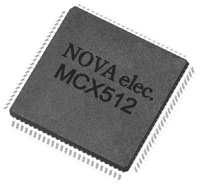- HOME
- Motion Contorol ICs
- MCX512
MCX512-High performance 2-Axis Motion Control IC

MCX512 can perform 2-axis linear interpolation, circular interpolation, bit pattern interpolation and continuous interpolation driving.
MCX512 has no multiple of speed (Range Setting) to set the drive speed. This will enable us to freely set the speed from 1 pps up to 8 Mpps in increments of 1 pps.
|
|
trapezoidal acceleration/decelerationl l acceleration/deceleration driving |
|
Interpolation
By adding new interpolation functions, more useful and more various interpolation can be executed.
 |
●8 Stages of Pre-Buffer for Continuous Interpolation MCX512 is equipped with 8 stages of pre-buffer register that stores finish point data (and others) in each segment, in order to handle continuous interpolation driving at high-speed. When there is a short segment such as Seg3, if the average driving time of 8 segments including Seg3 is longer than setting time of position data for next segment, continuous interpolation can be performed. |
|
 |
●Short Axis Pulse Equalization Mode In 2-axis linear interpolation, the axis (long axis) that has longer moving distance (pulse) outputs pulses continuously; however, the axis (short axis) that has shorter one sometimes outputs and sometimes does not output pulses depending on the result of interpolation calculation.MCX512 can improve this problem with the function: short axis pulse equalization mode. Even in the axis has shorter moving distance, it can output drive pulses as equal as possible. |
|
 |
●2-Axis High Accuracy Constant Vector Speed Mode MCX512 realizes 2-axis high accuracy constant vector speed mode that increases the accuracy of constant vector speed considerably, in addition to the existing constant vector speed mode. In 2-axis linear interpolation and circular interpolation driving, if the short axis pulse equalization mode described above and 2-axis high accuracy constant vector speed mode are used in combination, the speed deviation of vector speed can be within ±0.2% or less, and it will considerably improve the speed accuracy in interpolation driving. |
I2C serial interface bus
As connection interfaces to a host CPU, this IC has I2C serial interface bus in addition to the existing 8-bit/16-bit data bus. Max 8pcs of MCX512 can be connected to one bus.

Speed range-free
MCX512 has speed range-free function. This will enable us to freely set the speed from 1 pps up to 8 Mpps in increments of 1 pps.
When using the multiples of speed to set the speed by existing method, there are restrictions as described below.
・ For the detailed speed setting of low-speed, less multiples of speed must be set.
→ As a result, driving cannot be shifted to high-speed.
・ To perform the high-speed driving, larger multiples of speed must be
set.
→ As a result, the detailed setting of drive speed cannot
be configured.
MCX512 brings solutions to the inconvenience described above by Speed range-free,
which makes it possible to directly change the speed from low-speed such
as 1 or 2 pps to high-speed such as 1 Mpps during the driving.

Synchronous action
 |
●Outputs an external signal when passing through a specified position during the driving. ●Saves the current position to a specified register when an external signal is input during the driving. ●Outputs a number of split pulses from a specified position to the external during the driving. And so on. |
Output of Split Pulse

